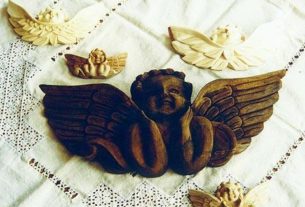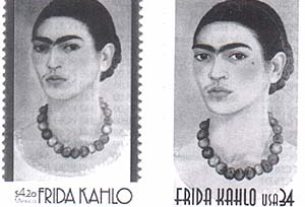Mayan Numeric System
Ancient Maya discovered two fundamental ideas in mathematics: positional value and the concept of zero. This feat was accomplished by only one other great culture of antiquity, the Hindu. But they did it 300 years or so after the Maya.
These two elements, positional value and zero, might be considered simple and basic concepts nowadays. In fact, they are, and that is precisely what set them apart as a distinct stroke of genius. Greek and Romans, with all the force of their spirit and all the strength of their institutions, did not manage to find these principles. Just try to write down a large number using the Roman notation to see how important are the notions of positional value and zero.
The Maya system is based on the number 20, not on the number 10 as our own. This means that the Maya counted from zero to nineteen before they had to move to the next order, instead of using 10 digits, from zero to nine, as we do. Perhaps they employed fingers and toes to keep the count.
In a decimal system the positional value is met as soon as we reach beyond number nine. A one followed by a zero is a ten. In the Maya system, a one followed by a zero equals twenty.
Our numeric system employs ten symbols to represent each one of the digits. Maya numerals were written with only three symbols: a dot for one; a line, which is a five, and the glyph of a sea shell to represent zero.
In that way,

And the first twenty numerals would be:
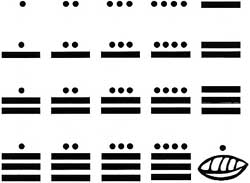
The Calendar
Another miracle produced by the Mayan culture was the long count calendar, a system more precise than the Gregorian corrected calendar, which is the one we currently use. A simple comparison illustrates the degree of perfection attained by the Maya in their time measurements:
Duration of year according to
modern Astronomy:
Ancient Roman (Julian), not corrected year:
Gregorian corrected year used today:
Ancient Maya long count calendar:
365.2422 days.
365.2500
365.2425
365.2420
The basic unit for the Maya calendar is the day, or kin. The second order of 20 days was called uinal. In a perfect vigesimal numeric system, third order should contain 400 days (20 x 20 x 1); but at this point Maya priests introduced a variant for calendar computation purposes. The third order, or tun, was made by 18 uinals, or 360 kins. This came closer to the duration of the solar year.
After the third order, the progression was uniform:
20 kins = 1 uinal = 20 days.
18 uinals = 1 tun = 360 days.
20 tuns = 1 katún = 7,200 days.
20 katuns = 1 baktún = 144,000 days.
Every date expressed in long count terms contained five numerals, that is, the number of baktuns, katuns, tuns, uinals and kins elapsed from the “beginning of time”, according to the Maya system.
By using different means and correlations, it has been established that the year zero for the Maya calendar corresponds to the year 3113 B.C.
Taking all this into account, it is clear that we now have all the necessary elements to translate long count Mayan dates to Christian dates.
An example:
Stone estelas erected by the Maya, specially during the Classical Period, were meant to commemorate important dates or events. The date was engraved or painted on the stone, and it invariably contained the same elements: an introductory glyph to the long count (meaning, “A long count date follows”), and the five numerals for the long count itself. Apart from that, the estela was covered with data to compute lunar correction for the calendar, different glyphs, and perhaps representative images.
One of the most ancient dated Mayan artifacts found to this day is the renowned Leyden plate, thought to be handcrafted in Tikal, though it was found in Puerto Barrios, Guatemala, in 1864. It is a small object, carved from jade stone in the shape of an ax head, and engraved on both sides:
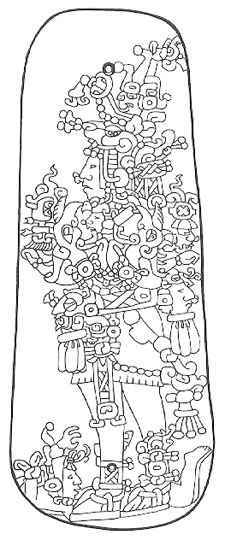
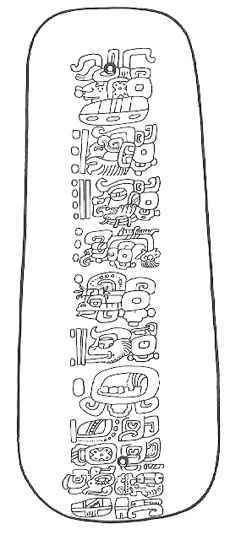

As we are already familiar with Mayan numerals, it should be easy for us to read the date engraved on the Leyden plate: 8.14.3.1.12. This means that from year zero in the Maya calendar to the written date, the total of days elapsed were:
8 baktuns x 144,000 days =
14 katuns x 7,200 =
3 tuns x 360 =
1 uinal x 20 =
12 kins x 1 =
Total of days elapsed = Days
1’152,000
100,800
1,080
20
12
1’253,912
We know that a year has 365.242 days. So now we will divide the total of days elapsed calculated above by the number of days in a year to obtain the number of years elapsed, according to the date engraved on the plate:
1’253,912 / 365.242 = 3,433.1 years.
If date zero in Mayan chronology corresponds to the year 3113 B.C., we just have to subtract to determine the equivalent Christian date written on the Leyden plate:
3,433 – 3,113 = 320 = 320 A.D.
A simple program
All these calculations can be easily mechanized on a programmable pocket calculator. In that way the traveler will be able to read the Mayan long count date numerals on the field to then punch them on the calculator to immediately obtain a translation to Christian date format.
For countless years my pocket HP12C has given me flawless service. (No, I don’t get a commission for this.) This is a listing of the instructions to be stored in this little machine to build a Maya to Christian date translation program:
f CLEAR PRGM
f P/R
RCL 1
144000
x
RCL 2
7200
x
+
RCL 3
360
x
+
RCL 4
20
x
+
RCL 5
+
365.242
: [division] 3113
–
f P/R
Before you run the program, be sure to store in memories 1, 2, 3, 4 y 5 of the calculator the numerals for baktuns, katuns, tuns, uinals and kins:
[Number of baktuns] STO 1
[Number of katuns] STO 2
[Number of tuns] STO 3
[Number of uinals] STO 4
[Number of kins] STO 5
After that, it is convenient to fix to zero the number of decimals to display, in order to obtain answers in whole years, to then execute the program:
f 0
R/S
If the answer we get is a negative number, this means that the calculated date is Before Christ. Positive numbers indicate After Death dates.

